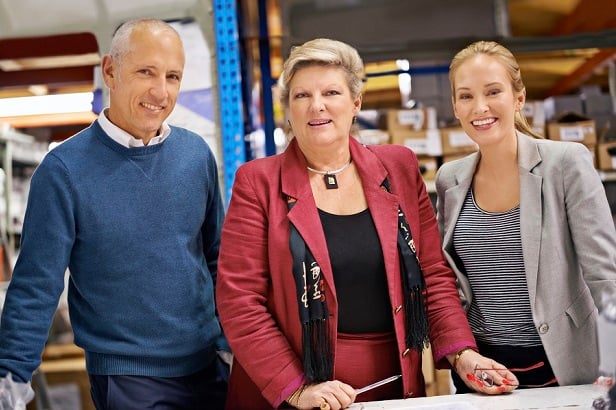 The ability to spot, mobilizeand deploy older workers is the next biggest source of competitiveadvantage in the U.S. By 2020, over one-quarter of the workforcewill be over 55 years of age.(Photo: Getty)
The ability to spot, mobilizeand deploy older workers is the next biggest source of competitiveadvantage in the U.S. By 2020, over one-quarter of the workforcewill be over 55 years of age.(Photo: Getty)
(Bloomberg Opinion) –Bloomberg asked readers a year ago: “Areyou about to be replaced by a robot?” Next the question became astatement: “Robots Are Coming for Jobs of as Many as 800 MillionWorldwide.”
|Does the real-world experience so far back up the fears? Japanand the U.S. are two of the countries most advanced in robotdeployment, and yet both are very close to full employment.
|To be sure, introducing more software and more robots into theworkplace introduces very real problems of training and retraining,but there will always be more work to be done.
|Scary as the rise of robots apparently is, perhaps it's afixation because it's actually less scary than the real socialissues ahead. One of those is how to integrate growing numbers ofelderly into the workplace.
|More elderly workers will force many people to confront theirbiases, fears and prejudices, probably leading to a bigger culturalclash than that with the machines.
|No matter how much they may disavow explicit age discrimination,many companies try to portray themselves as cool places to work foryoung people.
|And indeed these companies are especially interested in hiringyounger people: The median age at the hot tech companies rangesfrom 27 to 31. It's 38 at IBM and 39 at Hewlett Packard, stillyoung by most standards, but in the tech industry those are viewedas much stodgier places to work. Overall, the median age ofAmerican workers is a little over 42.
|It is not a surprise that tech companies should have so manyyounger workers, because younger people probably are on averagemore in touch with the latest developments in rapidly changingfields, such as programming and software. Younger people also seemmore interested in putting in the sometimes crazy hours behind manystartups, because they have a higher overall career return fromdoing so.
|Of course, American business is becoming more like the techsector as more companies are incorporating tech innovations. Thatdevelopment may not favor elderly workers.
|Squeamishness about the elderly manifests itself in advertisingtoo. Retirement products and Viagra are exceptions, but so many adsuse young actors because companies are image-conscious.Collectively it amounts to a harmful form of age discrimination.These biases toward youth may be a greater problem in America,which typically has prided itself on being a young, dynamicculture, always riding the next wave of change.
|There is also a practice, hard to avoid even in efficientworkplaces, to reward workers to some extent on the basis ofseniority alone. In the longer run that makes elderly workers apotential target for cost-cutting, even if they are doing a goodjob.
|Of course, the age structure of America's workforce is moving inthe opposite direction of these trends. The populations of the U.S.and many other developed nations are aging, and the big surprisehas been that older people want to work more than in previousgenerations.
|Against many prior expectations, the labor-force-participationrate of older Americans started rising in the 1980s and 1990s. Forinstance, the labor-force-participation rate for men ages 65 to 69was 25 percent in 1985 but 37 percent in 2016. By 2020, overone-quarter of the workforce will be over 55 years of age.
|I would suggest that the ability to spot, mobilize and deployolder workers is the next biggest source of competitive advantagein the U.S. The sober reality is that many companies should retooltheir methods to fit better with the experience and sound judgmentfound so often in older workers.
|That also will involve a retooling of the glamour notion tovalorize the young less and the idea of maturity more. HRdepartments may have to work harder to help older workers keep upwith new technologies.
|That prospect doesn't make for exciting headlines as a robottakeover does. But most of the story of economic success involvessuch small changes. And do you know which group of workers oftenunderstands that best? The older ones.
|Of course, some sectors have welcomed elderly workers with openarms. In academia, the practice of mandatory retirement at age 70has been replaced by permanent tenure, because of changes in thelaw. This has happened without incidence, though it may bringlong-run fiscal problems if more people work through their 80s andbeyond. On the bright side, that development might induce abeneficial modification of the tenure system, and a move towardgreater contract flexibility.
|Our willingness to banter about the robot apocalypse is yetanother sign that, too often, we just don't want to confront theissues surrounding the elderly.
|Copyright 2018 Bloomberg. All rightsreserved. This material may not be published, broadcast, rewritten,or redistributed.
Complete your profile to continue reading and get FREE access to BenefitsPRO, part of your ALM digital membership.
Your access to unlimited BenefitsPRO content isn’t changing.
Once you are an ALM digital member, you’ll receive:
- Critical BenefitsPRO information including cutting edge post-reform success strategies, access to educational webcasts and videos, resources from industry leaders, and informative Newsletters.
- Exclusive discounts on ALM, BenefitsPRO magazine and BenefitsPRO.com events
- Access to other award-winning ALM websites including ThinkAdvisor.com and Law.com
Already have an account? Sign In
© 2024 ALM Global, LLC, All Rights Reserved. Request academic re-use from www.copyright.com. All other uses, submit a request to [email protected]. For more information visit Asset & Logo Licensing.








